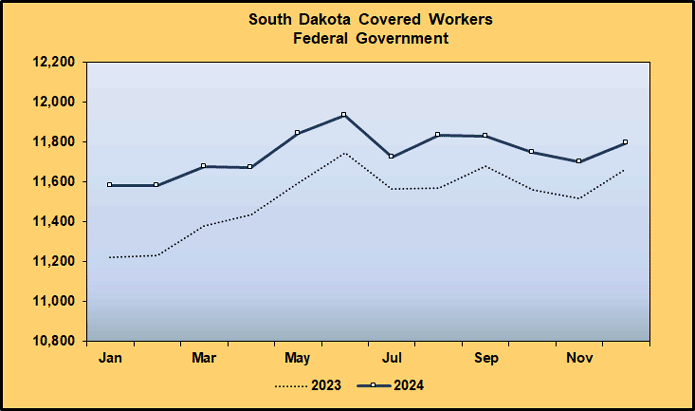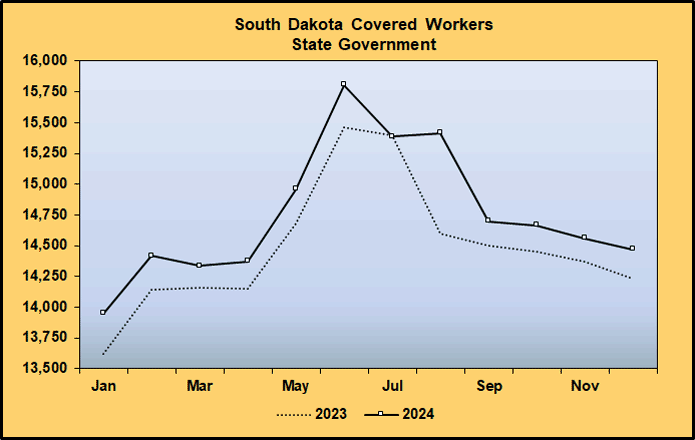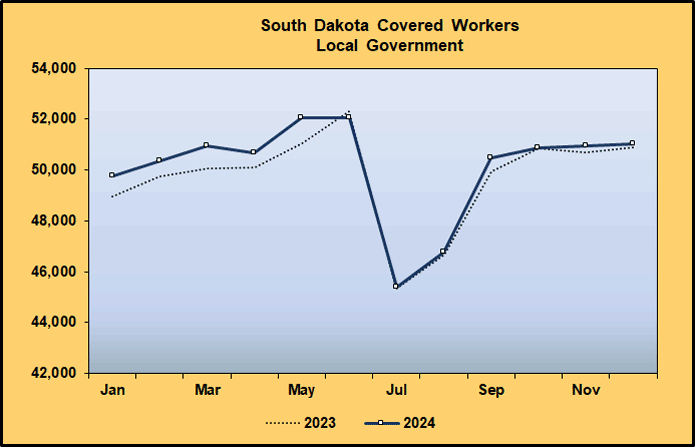- Home to LMIC
- Virtual Labor Market Data System
- Career Exploration & Planning
- Consumer Price Index
- Demographics
- Economic Snapshot
- Employee Benefits
- Employment Projections
- Labor Force & Unemployment
- Labor Supply
- Overview of the Current Labor Market
- Surveys We Conduct
- Wages & Income
- Workers by Industry
- Tools & Resources
- Publications
- References
- What's New
- Can't Find It?
Labor Market Information Center
2024 Annual Report
Quarterly Census of Employment and Wages
Public Administration Supersector
NAICS Sector 92
The Public Administration supersector contains information on Federal, State and Local Governments. Tribal governments are included in local government. A change in federal law requires Indian tribes to be classified similarly to state and local governments.
| South Dakota Covered Workers and Pay 2024 |
|||
| Supersector, Sector | Number of Establishments | Average Number of Workers | Annual Pay |
| Public Administration | 2,399 | 76,608 | $56,474 |
| Federal Government | 756 | 11,742 | $85,214 |
| Federal Government | 756 | 11,742 | $85,214 |
| State Government | 777 | 14,753 | $67,338 |
| State Government Education | 13 | 5,735 | $67,486 |
| State Government, excluding Education | 764 | 9,018 | $67,243 |
| Local Government | 866 | 50,113 | $46,542 |
| Local Government Education | 226 | 27,246 | $46,147 |
| Local Government, excluding Education and Tribal Government | 565 | 15,038 | $47,604 |
| Local Tribal Government, excluding Education | 43 | 5,965 | $44,049 |
| Local Tribal Government Education | 32 | 1,864 | $51,720 |
| See summed data for Local Tribal Government. Totals may not add due to rounding. Data subject to revision. Produced by the Labor Market Information Center, South Dakota Department of Labor and Regulation, in cooperation with the U.S. Bureau of Labor Statistics. |
|||
Federal Government
The number of Federal Government workers increased by 230 (2.0%) from 2023 to 2024 to a new level of 11,742. Annual pay increased $3,620 (4.4%) for a new level of $85,214. Federal Government remains one of the highest paying industries in South Dakota.
Federal government distinguishes power between a strong, larger central government and smaller local and state governments. The federal government sometimes is simply referred to as “Washington” and has three distinct branches: legislative, judicial, and executive, whose powers are vested by the U.S. Constitution through congress, federal courts, and the president, respectively. Some areas of public life are under the control of the national government, and some areas are under control of the local governments. The constitution stipulates what areas of public life are controlled by the federal government and what areas state governments regulate. Ideal examples of federal governments are those that function best in large countries with wide-ranging, diverse groups of people with unique needs. The federal government helps address the wide multiplicity of needs of a geographical area. Only the federal government can regulate interstate and foreign commerce, declare war, and set taxing, spending, and other national policies.
Like last year, federal worker levels in Administration of Human Resource Programs experienced an increase in 2024, up 69 workers to a level of 803. Annual average pay increased $6,070 to settle at $95,838. This category is characterized by administration of educational, public health, and veteran affairs programs. Public health programs and services require workers to carry out health activities, health statistics, mental health assistance, and immunization programs. Veteran’s affairs offices and benefits program administration often supply assistance, training, counseling, and other services to veterans and their dependents or survivors. This industry includes Veterans Affairs offices that maintain and coordinate activities with other service organizations and governmental agencies.
National Security and International Affairs agencies tallied an increase of 35 workers in 2024. These agencies are primarily involved in national security and international affairs. The armed forces, including the National Guard, are in this industry group, as are military bases and military reserves.
There was an increase of federal workers within Administration of Environmental Quality Programs. This grouping had a gain of 32 workers, reaching a level of 1,061 in 2024. Most of the gain was within the administration of conservation programs. These agencies are primarily engaged in the administration, regulation, supervision, and control of land use. Included are recreational areas, conservation and preservation of natural resources, weather forecasting administration, and the protection of public and privately owned forest lands. This industry also includes agencies responsible for management and regulation of game, fish, and wildlife.

State Government
Worker numbers in State Government increased by 274 from 2023 to 2024 for a new total of 14,753 (1.9% growth). State government employment has had minor increases or decreases spread out amongst several agencies over the last few years. Annual pay increased 6.3% in 2024, for a new level of $67,338.
State government makes and enforces laws for a state. Modeled after the Federal government, state government consists of three branches: executive, legislative, and judicial. The U.S. Constitution mandates that all States uphold a form of government, although the three-branch structure is not required. State governments administer to the local needs of an area. State governments have certain reserved powers, specific authority, and responsibilities that the national government does not have. In general, state governments are responsible for regulating trade within state borders and for establishing regulations for local corporations. State governments also administer to the needs of the many smaller local governments by establishing charters for county and city government. State governments play a dynamic role in regulating the educational system of their states and establishing licensing rules for professionals who practice in the state. State governments exercise essential functions within the United States. They are responsible for governing to the local needs and problems of the state. The state constitution usually stipulates what powers and responsibilities state government has. They propose, strategize, and pay for most roads, operate public schools, provide water, establish zoning regulations, arrange elections for their citizens, and prepare policy.
The Justice, Public Order, and Safety Activities subsector added 262 workers (14.9%) in 2024. There are now 2,015 employees working in these state establishments. Annual wages increased by 6.0%, gaining $4,035 to close at $70,769 for the year. Civilian courts of law along with sheriffs’ offices conducting only court functions, legal counsel and prosecution, fire protection, and correctional institutions all played a role in employment gains. Correctional institutions are in engaged in managing and operating facilities designed for the confinement, correction, and rehabilitation of adult and/or juvenile offenders sentenced by a court.
Administration of Economic Programs experienced a worker increase of 29 (3.8%) throughout 2024. Annual pay increased by 5.6%, up $3,327 to a new average of $62,305 for the year. The increase was largely due to the internal regrouping or redistribution of employees within the Departments of Environmental and Natural Resources, and Agriculture. The regulation of Agricultural Marketing and Commodities programs was responsible for the growth. Agriculture is the lifeblood of South Dakota and the state’s number one industry, so it is appropriate that agencies in 2024 continue to support agricultural programs through administration, and coordination of marketing and promotional activities. Agencies in this industry also regulate and control the inspection of food, plants, animals, and other agricultural products.
Executive, Legislative, and Other General Government Support, Administrative of Human Resource Programs, and National Security and International Affairs government offices experienced some worker losses during 2024. These agencies have various functions and advisory capacities to support public programs and other government agencies.
Educational Services is an additional subsector which showed employment gains in 2024, with a 99-worker hike bringing the new level to 5,735. Annual pay had a gain as well, reaching $67,486. Higher education led the increase. People continue to realize the importance of education. With the flexibility of education programs now being offered to meet a wide range of students' needs, educators and staff are being added to payrolls to provide services in a wide variety of locations and settings to help students earn degrees at baccalaureate and graduate levels.

Local Government
Local Government worker levels increased by 392 workers (0.8%) from 2023 to 2024 for a new figure of 50,113 employees. Worker gains the past four years have made up for losses in 2020. Local government displayed a $2,220 increase (5.0%) in annual pay for a new 2024 level of $46,542.
Local Government is an administrative body for a slighter-scale geographic area, such as a city, town, county, or district. Local governments are institutional units whose fiscal, legislative, and executive authority extends over the smallest geographical area distinguished for administrative and political purposes. It refers to the operations of corporations, municipalities, district boards, and other bodies that are entrusted with the execution of functions relating to and concerning the residents of a given locality. Local governments extract their authority from the state in which they are located. Local governments routinely have control over their exclusive geographical region and cannot pass or enforce laws that will affect a wider area. Local governments can elect officials, enact taxes, and do many other things that a national government would do, but on a smaller geographic scale.
Through the Educational Services subsector, local government plays a key role in public education in South Dakota and throughout the United States from kindergarten to high level college, providing primary funding for public schools, using money largely raised through state and local taxes. In fact, Educational Services makes up more than 50% of all local government employment. This subsector expanded its workforce by 235 (0.9%) in 2024, finishing the year at 27,246. Annual pay increased to $46,147 (4.6%). Elementary and secondary schools gains were comparable to 2023 gains. Colleges, Universities, and Professional Schools also increased worker levels. Although small, worker gains were exhibited in junior colleges and community colleges, which furnish academic or technical courses and grant associate degrees, certificates, or diplomas below the baccalaureate level. These colleges and professional schools may provide instruction in diverse settings, such as at the client’s training facilities, educational institutions, or the workplace. Training may be delivered through diverse means, such as the internet, or other electronic and distance-learning methods. As was the situation in 2021, schools were close to being back to normal staffing levels following the COVID-19 pandemic. Classrooms filled up again, and schools re-staffed accordingly to provide teaching and extra curricula activities.
The public administration subsector, Executive, Legislative, and Other General Government Support, produced gains of 94 workers in 2024. The growth was in Executive and Legislative Offices, Combined. Annual wages rose by $2,838 for a new annual average of $48,159. Executive and legislative office combinations belong in this group. This industry includes councils, boards of commission, and legislative bodies. These types of offices offer planning, coordination, and technical assistance. They also oversee programs at a regional level and can act as intermediaries between local government and the state or federal government. Other general government support agencies and tribal governments are included in this grouping. Public property management services and purchasing and supply agencies are valuable agencies offering a range of service support to help maintain business operations. It is important to remember that tribal government has been included in Local Government since 2001.
The remaining public administration subsectors yielded little or no change in worker levels from 2023 to 2024. These include Justice, Public Order, and Safety Activities; Administration of Human Resource Programs; Administration of Environmental Quality Programs; Administration of Housing Programs; Urban Planning and Community Development; and Administration of Economic Programs. All these agencies and administrations provide an array of essential services and support. They coordinate, plan, and supervise policies for their respective centralized programs.

